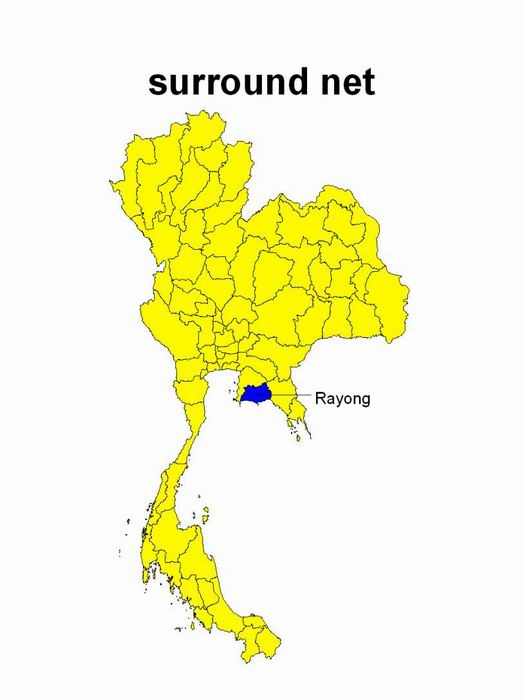Surrounding nets without a purse line
The
simplest in construction and in the method of operation are the surrounding
nets without a purse line. They have traditionally been used on a small-scale
in coastal waters, for catching anchovies, rock-fish and other near-shore species.
Anchovy
surrounding net (Uan Glud Takhao)
It
is usually operated from a small boat, (8-14 meters long,
6-20 h.p. engine), by 6-10 fishermen. The net is rectangular,
200-400 meters long and 10-15 meters deep. The main
net consists of 6.4 x 6.4 – 7.4 x 7.4 mm nylon minnor
netting, or 6.3 – 8.3 mm rachel net. Polyethylene 250
d/12 netting is used for lower selvedge. Float line
is longer than sinker line, buoyancy force is about double
of the sinking force. C-shaped steel hooks are used
for closing the bottom part of net.
Fishing
operations are conducted in the early morning and evening,
in 2-10 meters of water depth near the shore. A fish
school is located by a simple visual search. The only
piece of equipment apart from the net is an air compressor
on board, to supply air to the fisherman who dives when the
bottom of the net has to be closed.
Fishing
grounds are sandy or mud and sand, mostly in Rayong, Chantaburi
and Trat province.
Rock-fish
surrounding net (Uan lom lung hin)
It
was developed from anchovy surrounding net, therefore the
fishing method is the same. There are, however, some
differences in net materials and fishing grounds. In
this case, 25 mm mesh size, nylon 210 d/6 is used for the
main net, and 30 mm, polyethylene 380 d/12 is used for selvedge.
Fishing
grounds are where the bottom is rocky, or around a reef. The
principal target species are yellow-tail fusiliers, rabbit
fish, cavalla, barracuda and other coral fishes. The
gear is found in the eastern Gulf of Thailand, A. Makhampom,
in Rayong province.

|